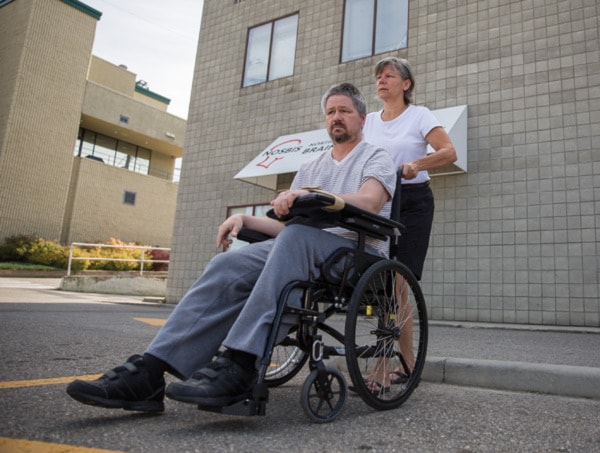Life changed drastically for Mark Moerike one night in November 2013.
Mark’s spouse Reta awoke to a crash, and found Mark on the floor beside the bed.
The 49-year-old had suffered a severe stroke, leaving him with paralysis on one side of his body.
Mark now navigates his world in a wheelchair, where the obstacles he encounters are not merely of the physical variety. Awareness of what an accessible building should feature is a big one, explains Reta.
Shortly after the stroke, the couple had to go to two buildings which don’t accommodate wheelchairs well: the Interior Health outpatient lab and the North Okanagan-Shuswap Brain Injury Society office.
The NOSBIS office near NAPA Auto Parts does not have a handicapped parking stall; the closest one is over at the Ross Street parking lot. As well as wheeling down the block, crossing the street and wheeling on the road, Reta says a patron must navigate a pole before entering the office.
“The likelihood of someone doing that is difficult.”
Up at the lab, there are two doors that can be opened by pushing a button, but then there’s a wall.
“It’s difficult to back up and back around, so you need assistance.”
Reta says it may seem picky to mention these things, but her eyes have been opened as she’s helped her 225-pound spouse get around town. If the goal is independence, then changes must be made.
“It’s these little things I don’t think people pay attention to. They might follow building codes, but it’s the minor things. It seems petty, but it’s significant.”
Reta points to the pavers that have been added around the city. They can shift and create a lip coming up to the sidewalk.
“Instead what they could do is dye the concrete. If they want something more aesthetically pleasing, they could do it with colour instead of texture.”
Another example is the couple’s dentist office. There’s no handicapped parking stall and no accessible washroom.
Lots of restaurants have ‘accessible’ washrooms, she’s noticed, but they’re not really because a person in a wheelchair can’t navigate them alone. Also, many push-button doors open outwards, so a person must back up to avoid getting hit.
On the flip side, she says, is the Shaw Centre, which is very accessible.
Coming off the sidewalk into the building is smooth and the elevator has two doors so a person in a wheelchair can go in one and out the other.
“Mostly importantly the seating is in with the others, so you don’t feel like you’re isolated behind some railing.”
In many ways it’s a mindset. Reta has observed that able-bodied people use handicapped parking stalls without thinking.
She was told at one, ‘it’s OK, my friends just ran in, they’ll be out in a minute.’
“It’s that respect for a handicapped stall,” she says, suggesting that perhaps a two-tiered system would work where some stalls are specifically for wheelchair users.
With an aging population, Reta notes that it would be financially beneficial for stores to have readily accessible handicapped parking stalls. As would constructing homes for ‘aging in place.’
She has been reading about universal design, where accommodating disabilities is not an afterthought. For example, “when you build classrooms, instead of an FM system for hearing impaired (students) after the fact, do it before.”
She’s also noticed anything that’s about accessibility is a niche market.
“If I go buy something as simple as a shower head, you pay three times as much if it’s ‘handicapped.’”
Overall, Reta emphasizes that while all these things might seem minor, they can make a huge difference.
“Already faced with so many frustrations, not having an accessible community makes it more difficult. People are nice and helpful. But Mark had many, many years of being independent, and to lose your independence in a moment – he feels like he’s the side show. Many times, somebody has to come to his assistance. So what happens is he avoids coming into the community.”
